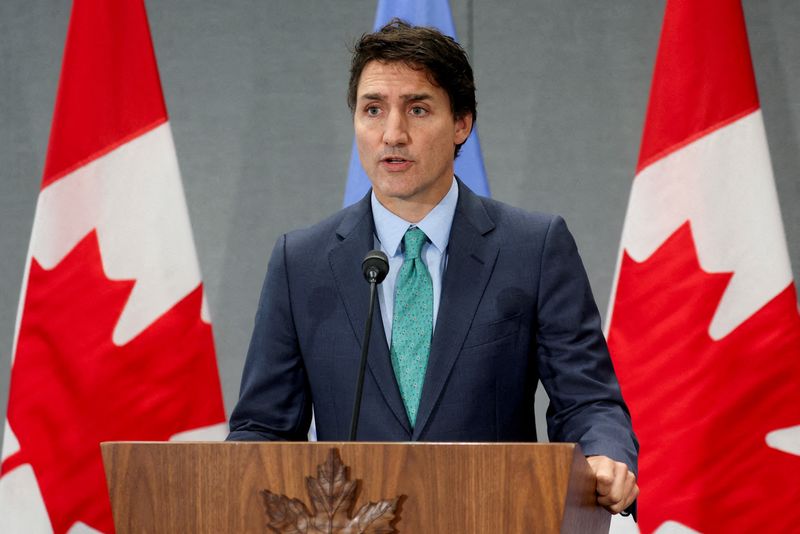Explainer-How would Canada’s proposed oil and gas emissions cap work?
2023.12.06 09:50

© Reuters. FILE PHOTO: Canadian Prime Minister Justin Trudeau holds a press conference on the sidelines of the UNGA in New York, U.S., September 21, 2023. REUTERS/Mike Segar/File Photo
By Nia Williams
(Reuters) – Canada plans to unveil a framework for its long-awaited oil and gas emissions cap at the United Nations COP28 climate summit in Dubai, the only major only-producing country developing such a policy.
Here are details of what it is expected to entail, and what it will mean for the fossil fuel sector:
WHAT IS THE OIL AND GAS EMISSIONS CAP?
Canadian Prime Minister Justin Trudeau first promised a cap that would limit oil and gas emissions during his 2021 re-election campaign. It is a key part of Canada’s pledge to cut greenhouse gas 40-45% below 2005 levels by 2030, and no other sectors of the economy faces such a cap.
The government will table a framework for the cap at COP28, which runs till Dec. 12, ahead of draft regulations next year.
Federal Environment Minister Steven Guilbeault described the framework as a “plain language document” that would give the main elements of the regulations.
Ottawa plans to set an upper limit for oil and gas emissions that will shrink over time, but has not yet said what the limit will be or how it would be regulated. Natural Resources Minister Jonathan Wilkinson said last month the government wanted to achieve the biggest emissions cuts possible without shutting in production.
But Canada’s main oil province Alberta is strongly opposed to the emissions cap, arguing it would limit production.
WHY IS IT IMPORTANT?
Canada is the world’s fourth-largest oil producer and the oil and gas industry is the country’s highest-polluting sector, responsible for more than a quarter of total emissions.
In 2021, oil and gas emissions totalled 189 million metric tons, an increase of 3% from the previous year and 12% from 2005, which undercut decarbonization in other sectors like electricity.
Canadian oil producers have ramped up production in anticipation of increased export capacity when the expanded Trans Mountain pipeline starts up next year.
Projections from the federal government’s Emissions Reduction Plan (ERP) suggests oil and gas emissions would need to drop to 110 million metric tons by the end of this decade for Canada to meet its 2030 target.
Guilbeault told Reuters in an interview on Tuesday the emissions cap would be close to what is in the ERP.
HOW CAN CANADA CUT OIL AND GAS EMISSIONS?
On Monday, Canada issued draft regulations that toughen its standards on methane emissions. The Canadian Climate Institute (CCI) think-tank says tougher methane rules could drive a third of the emissions cuts needed to get oil and gas pollution to the 110-megatonne level by 2030.
Carbon capture and storage (CCS), electrification and co-generation of power can also contribute to reducing emissions. The CCI said there are solutions available to make an emissions cap work without the oil and gas sector having to cut production, but government and industry should move fast.
WHY IS IT CONTROVERSIAL?
The Pathways Alliance, a consortium of Canada’s six-largest oil sands producers proposing a C$16.5 billion ($12.14 billion) CCS project, says it is concerned “impractical and unachievable” timeframes for cutting pollution targets could drive away investment.
Alberta Premier Danielle Smith cites the emissions cap as another example of federal government over-reach, and has vowed to ignore it.
The province is battling a number of Trudeau’s other climate policies, including proposed Clean Electricity Regulations, and recently scored a win when Canada’s Supreme Court said a federal law assessing how major projects impact the environment was largely unconstitutional.
($1 = 1.3593 Canadian dollars)








